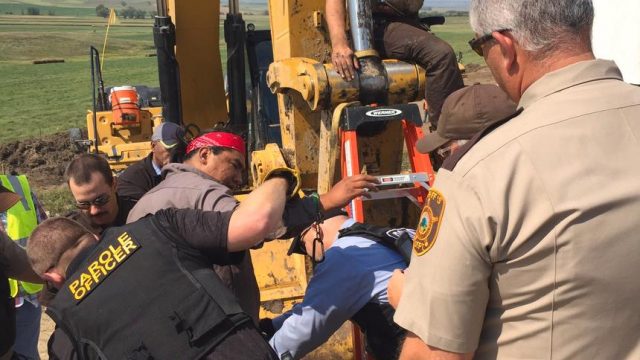Surprise: Dakota Access Pipeline Follows Existing Gas Line Through Protested Area

Over the holiday weekend I spent time going through the U.S. Army Corps of Engineer’s 1,206 page Mitigated Finding of No Significant Impact report related to the Dakota Access Pipeline (see it below).
It’s the document upon which the Corps based its decision to approve building of the pipeline, a decision the Standing Rock Sioux Tribe is now contesting in court, and it’s worth your time to read. Anyone claiming that the process to approve this pipeline wasn’t both thorough and exacting has no idea what they’re talking about.
Anyway, I noticed something interesting as I read through the report. On page 1008 I found a graphic showing the portion of the pipeline which crosses the Missouri River/Lake Oahe. You can look at it below. What surprised me was that black dotted line marked as an existing pipeline (click for a larger view):
Before reading this report I had no idea there was another pipeline already running through this area, but there is. It’s called the Northern Border Pipeline. It’s a natural gas line built all the way back in 1982, and the Dakota Access Pipeline follows it often, including through the areas currently being disputed by protesters.
This image from the North Dakota Pipeline Authority shows the route of the Northern Border line (in blue) through the state:
This map shows the route of the Dakota Access Pipeline:
This is no mere coincidence. I spoke with Justin Kringstad at the ND Pipeline Authority who told me that the Dakota Access line “generally follows the same corridor” as the Northern Border line, and that this sort of thing is “not uncommon.” It can be easier to get easements and regulatory approval for a pipeline built where another pipeline has already gone through.
Public Service Commissioner Julie Fedorchak also told me that the Dakota Access line “tried to follow wherever possible the Northern Border pipeline.”
The two routes aren’t exact, but through the area where pipeline construction has sparked violent protests the two lines run side by side according to Energy Transfer Partners.
“We parallel this pipeline for about the last 40 miles” leading up to the Missouri River/Lake Oahe crossing spokeswoman Vickin Anderson Granado told me.
What’s interesting is that the Northern Border line doesn’t seem to have prompted any protests or complaints from the Standing Rock tribe according to the Federal Energy Regulatory Commission’s Environmental Impact Statement for the pipeline:
Today the Standing Rock Sioux Tribe has claimed that the Dakota Access Pipeline will destroy significant cultural artifacts along its route, but made no such claims about the Northern Border line.
[scribd id=323278826 key=key-BPmGgsEv4CX3tAcyy780 mode=scroll]







